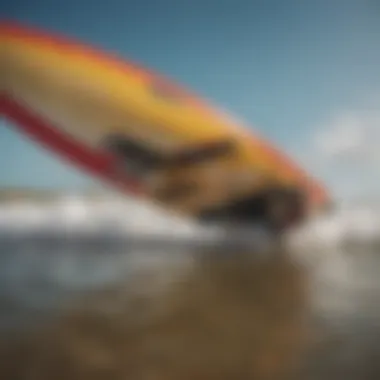Choosing the Right Size Kiteboard for Performance


Intro
Choosing the right size kiteboard is not just about picking the prettiest board or the one that you fancy the most at your local shop. It’s an art and a science wedged between your weight, your skill level, and the kind of water you’re dealing with. Whether you’re a wet-behind-the-ears newcomer or a seasoned kiteboarding wizard, understanding the intricacies of board sizing can significantly enhance your overall experience on the water. This article aims to peel back the layers of complexity surrounding kiteboard selection and equip you with the knowledge to make smart decisions that cater to your riding style.
Kiteboarding, in essence, is like dancing with the elements. The right gear, particularly your kiteboard, can elevate your moves from clumsy to graceful. Now, let’s unpack some fundamental insights before we embark on the journey of sizing your kiteboard!
Understanding Kiteboarding Basics
Kiteboarding is much more than just a sport; it’s a fusion of skill, thrill, and artistry that thrives on the interplay between the rider and the elements. Understanding its basics can significantly enhance your experience on the water, and when looking for the right gear, knowing the intricacies of kiteboarding becomes paramount. This part of the article lays the groundwork for those stepping into this exhilarating activity and highlights why comprehending kiteboarding fundamentals is essential.
The Essence of Kiteboarding
At its core, kiteboarding stands as a unique blend of surfing and kiting, allowing riders to harness wind power to glide over water. The adrenaline rush from riding waves, performing tricks, or even just cruising is something both novices and veterans relish. The sport, however, requires a deep connection between the kite, board, and rider.
Whether you're chasing the perfect wave or executing an aerial maneuver, understanding how kiteboarding operates aids in developing the required skills. The wind is not merely a background; it is a key player. Riders must grasp direction, strength, and how these variables affect their performance. Additionally, appreciating the nuances of kiteboarding culture—its community, events, and shared experiences—gives enthusiasts a greater appreciation for this complex yet rewarding pastime.
Key Components of Kiteboarding Gear
Familiarity with the essential kiteboarding gear is a must for any aspiring kiteboarder. Each piece serves a specific purpose and contributes to the overall performance on the water. Here’s a quick rundown of the gear:
- Kite: The heart of the operation. Kites come in various shapes and sizes, influencing your control and lift. Choosing the right kite depends significantly on your intended use, skill level, and the wind conditions.
- Kiteboard: This is where the rider stands. Boards vary in size, shape, and construction, affecting glide, boost, and maneuverability.
- Control Bar and Lines: These connect the rider to the kite, allowing you to steer and control the power. Understanding how to operate the control system is crucial for safety and performance.
- Harness: It connects to the control bar and plays a vital role in transferring the kite's power to the rider. A well-fitted harness can make a difference in comfort and performance.
- Safety Gear: Life jackets and helmets provide essential protection, particularly for new riders learning the ropes.
By gaining insight into these components, you not only prepare yourself for kiteboarding success but also enhance your safety and enjoyment. Each gear element interacts with others, creating a symphony of performance when all parts come together seamlessly.
Knowing your gear inside and out is like having a map before hiking a mountain. It guides you and ensures you find the best path forward.
Understanding kiteboarding basics isn't just about learning how to ride; it's about embracing the entire experience—from gear selection to understanding the wind—and that’s what truly sets the foundation for optimal performance in the sport.
The Importance of Kiteboard Size
When it comes to kiteboarding, the size of your kiteboard is nothing to sneeze at. It’s often overlooked or underestimated by beginners and even some seasoned riders. But the truth is, the right size kiteboard can make the difference between a thrilling ride and a frustrating experience. Understanding kiteboard size is not just about choosing one that looks cool; it’s about optimizing your entire performance out on the water.
How Size Influences Performance
One of the key aspects of kiteboarding performance lies in the size of the board. A board that’s too small can make you feel like you’re balancing on a tightrope, especially in choppy waters. It can be difficult to edge properly or maintain speed. On the flip side, a board that’s too large can feel unwieldy, limiting your maneuverability and even slowing you down.
In practical terms, a smaller board often offers better agility. If you fancy tricks, jumps, or any freestyle maneuvers, you'd likely opt for a smaller size. This allows quick turns and sharp edges, giving you that responsive feeling you seek. However, in gentler winds, a bigger board can help you get up on a plane more easily, avoiding that frustrating dip in performance when the breeze dies down.
Here are some points illustrating how size impacts performance:
- Wind Conditions: Lighter winds usually call for larger boards, as they provide more surface area for lift. Conversely, stronger winds favor smaller boards.
- Board Shape and Size: A wider board gives more stability but less speed, while a narrower board may slice through water but requires greater skill to control.
- Front Foot Pressure: A board with more size can allow for easier front foot pressure, which adds to overall control when riding.
Remember: The right board size ultimately leads to better control, higher speeds, and an overall more enjoyable ride.
The Relationship Between Size and Control
Control in kiteboarding is crucial. When you are zipping across the waves, there’s no room for uncertainty. The size of your kiteboard plays a significant role in how well you can steer and maneuver in various conditions. If you’re riding an oversized board, it may feel like steering a ship. This can hinder your ability to ride with confidence, particularly if conditions get bumpy or unpredictable.
Consider this simple analogy: Riding a kiteboard is like driving a car. A compact car offers better handling around tight corners, while a larger SUV might struggle. You need a board that matches your skill level and intended style of riding. A smaller board, albeit more challenging, can foster greater responsiveness and quick changes in direction, which is ideal for advanced riders.
- Comfort in Control: The right board size contributes to your comfort level. If you're riding in challenging conditions, feeling in control can mitigate the likelihood of accidents.
- Skill Development: Choosing the right size based on your current skills allows better focus on technique, leading to gradual improvement over time.
- Stability vs. Agility: Larger boards offer stability during gusty conditions, while smaller boards can allow for faster, more fluid movements when safety isn’t a primary concern.
In light of all this, kiteboard size is not a minor factor to consider. It impacts everything - how you ride and even how much you enjoy your time on the water. By integrating this knowledge into your selection process, you can elevate your kiteboarding experience to new heights.


Factors to Consider in Kiteboard Sizing
Selecting the right kiteboard size isn’t just a trivial decision. It can make the difference between skimming smoothly across the water or feeling like you’re dragging a brick behind you. Understanding the various factors that come into play when sizing your kiteboard is essential for anyone looking to improve their performance, stability, and overall enjoyment.
Key elements like rider weight, skill level, and prevailing water conditions all play pivotal roles in determining what size will best suit your unique needs.
Rider Weight Considerations
When it comes to choosing a kiteboard, the weight of the rider is one of the first factors to consider. This aspect holds significant sway over several other characteristics, such as board size and volume. Riders who weigh more often require larger boards to maintain buoyancy and support during rides. A larger board, typically more extended and wider, aids in distributing weight more evenly across the surface, offering better stability, especially in choppy water.
Conversely, lighter riders can opt for smaller boards which makes jumping or tricks easier.
Key points about rider weight:
- Buoyancy factor: Larger boards float better, making them ideal for heavier riders.
- Jumping capability: Smaller boards allow lighter riders to jump easier, needing less force to lift off the water.
- Skill match: Weight also correlates with skill; heavier novice riders may struggle with smaller boards, while a skilled lighter rider can handle them well.
Ultimately, riding effective will be a true reflection of how well the board matches your weight.
Skill Level and Its Impact on Size
Your skill level is another critical factor when determining the right kiteboard size. Beginners often find themselves more comfortable on larger boards. The extra surface area aids in stability, making it easier to balance when learning essential skills like riding upwind or executing transitions. A larger board can also handle gusty winds better, providing more control as novices navigate through their first few outings.
On the flip side, advanced kiteboarders often benefit from smaller boards. These allow for heightened maneuverability and precision during tricks, appealing to those who push the boundaries of their skillset.
Consider these elements regarding skill level:
- Beginner: Larger boards for easier navigation and learning curves.
- Intermediate: Mid-sized options can introduce new challenges and help with durability improvements in tricks.
- Advanced: Smaller boards for performance and agility, suitable for freestyle and complex maneuvers.
Adapting your size as your skill increases is equally crucial for continuous improvement.
The Role of Water Conditions
Water conditions is yet another factor worth considering. The width and length of the board can significantly influence your ride in varying weather and water surfaces. For instance, choppy waters may demand a wider board for stability, while smooth, flat conditions offer the opportunity to experiment with narrower boards.
Here’s what to keep in mind:
- Waves: In wave riding, a smaller, more maneuverable kiteboard is preferable. These boards can slice through water, allowing for quick turns and agile moves.
- Flat water: Larger boards can enhance speed and provide excellent control for beginners or casual riders.
- Wind strength: In lighter winds, larger boards help maintain power and glide, whereas stronger winds might call for smaller boards, allowing better control and response.
"Choosing the right size kiteboard is like finding the right shoes; it needs to fit just right for optimal performance."
Understanding these elements allows riders to adapt their board choice to remain effective in any given scenario. By tuning into rider weight, skill level, and water conditions, you’re primed to pedal through desires and ambitions with the right size kiteboard, turning those ideals into reality.
Choosing the Right Size for Different Riding Styles
When it comes to kiteboarding, understanding how to select the right size kiteboard for different riding styles is paramount. Each style of riding demands its own unique characteristics, which influences not only your overall performance but also your enjoyment on the water. A kiteboard that suits one style may hinder another, leading to frustration rather than fun. Let’s dig into the essentials behind choosing the appropriate size of kiteboard based on specific riding styles.
Freestyle Kiteboarding
Freestyle kiteboarding is all about tricks, jumps, and spins. Riders are typically looking for high performance when they launch into the air or land. Choosing a kiteboard for this style often leans towards a smaller board size. Smaller boards provide the necessary maneuverability and allow for quick direction changes, which are crucial for performing complex tricks. A board that’s too big can cause sluggishness as you unwind from rotations, playing a havoc on your balance and height in the air.
In freestyle, binding placement is also key: you might want them further apart for stability as you bounce and spin in the sky. Additionally, the size of the board might influence how comfortable it feels when landing. A smaller, lighter board can absorb impacts more softly, allowing for smoother landings.
Freeride and All-Around Styles
For those who like a bit of everything, from cruising to jumping and everything in between, freeride and all-around styles demand a kiteboard that strikes the right balance. A medium-sized kiteboard generally serves this purpose. With a bigger surface area than a freestyle board, it offers stability while still being manageable for jumps.
A medium board is versatile enough to handle slight variations in conditions, whether you’re catching waves or gliding across flat water. Here, rider weight and skill level start to come into play regarding size choice. A heavier rider might opt for a larger board to distribute their weight evenly, while someone lighter may want to stay on the smaller side for better navigation.


Wave Riding Techniques
When it comes to wave riding, the kiteboard size matters in a different way. The focus here is on how well you can maneuver through waves and less about jumping and stunts. A shorter and wider board can often be more beneficial for navigating choppy waters and maximizing turns. It lets the rider carve through waves effectively without losing speed and offers more control.
Riders should also take into account the expected wave size. In bigger waves, a slightly larger board could help maintain stability and control. Keep in mind that while a larger board may provide more buoyancy, it could also be cumbersome when trying to make quick turns. Some riders may even experiment with various sizes to find that sweet spot that allows them to adapt seamlessly to varying conditions.
"Choosing the right kiteboard size for riding style can make the difference between an exhilarating experience and a challenging one."
Ultimately, understanding your preferred riding style and its specific demands aids in selecting an appropriately sized kiteboard, which tells a lot about your success and enjoyment as a kiteboarder.
Common Misconceptions about Kiteboard Sizing
In kiteboarding, as in many sports, the right gear can make or break the experience. However, information can sometimes get jumbled up, leading to misconceptions about kiteboard sizing. Understanding these false beliefs is crucial, as it helps riders make informed decisions that directly affect their performance and enjoyment on the water. Misconceptions can lead to over-compensation in board size, resulting in a lack of control, stability, or even unnecessary fatigue. By clarifying these assumptions, kiteboarders can better match their equipment to their riding style and conditions, thus enhancing their time on the water.
Bigger Is Always Better? Debunking the Myth
One of the most common misunderstandings among novice kiteboarders is that a larger board automatically translates to better performance. This myth has roots in a few simple truths: a larger board does provide more float, which can be helpful in light winds. However, this does not mean it’s the right choice for everyone.
- Weight of the Rider: A lightweight rider may find a large board cumbersome, making it harder to maneuver or jump. What feels comfortable in your hands also impacts your performance.
- Riding Conditions: Depending on the wind conditions, larger boards may feel like a burden. In gusty winds, a smaller board allows for a quicker response, giving the rider more control.
- Riding Style: Freestyle riders need a board that enables rapid rotation and agility. A larger board can hinder tricks and responsiveness.
A balanced approach to board size, matched with ability and conditions, far outweighs the urge to simply go big. The essence of kiteboarding lies in finesse—not just raw size.
Size Impact on Wind Conditions
When it comes to windy days on the water, the size of your kiteboard can have a notable influence. However, size doesn't impact wind conditions; rather, it governs how effectively your board responds to them.
Light Wind Conditions:
- In lighter winds, a larger board helps maximize surface area, allowing you to glide more smoothly and maintain speed. But, beware—keep that floaty ride in check with your kite size as well!
Strong Wind Conditions:
- Conversely, when the wind is howling, a smaller board reduces surface area, enhancing control and reducing the potential for over-excitement during gusts. Finding harmony between board size and kite specifications becomes crucial in these situations.
A clear understanding of how size interacts with wind conditions will allow riders to adapt their gear choices effectively, enhancing overall performance.
Quote: "The equipment should complement you in every condition; finding the right balance is key to succeeding in kiteboarding."
When considering kiteboard sizing, it's essential to sift through the noise of myths and focus on factors that optimize your riding experience instead.
Practical Steps for Selecting the Right Size Kiteboard
Choosing the right size kiteboard can be the difference between a thrilling ride and a troublesome struggle on the water. It’s not just about sliding by on a board; the right fit enhances performance, stability, and enjoyment. Riding with a board that suits your profile can turn every session into a fun exploration rather than a frustrating chore. The following steps can help you navigate the seemingly overwhelming selection by breaking it down into manageable pieces.
Utilizing Sizing Charts Effectively
Sizing charts are a kiteboarder’s best friend when determining the right board size. Many brands provide detailed charts that correlate rider weight and board size, so you'll need to reference these before making a purchase. Here’s how to approach them:
- Understand the Metrics: The charts typically list recommended sizes for a specific weight range. Knowing your weight is crucial, and this often includes consideration for the gear you’ll wear.
- Assess Your Style: Keep in mind that the recommended sizes may vary based on whether you enjoy freestyle, freeride, or wave riding.
- Take Wind and Water Conditions into Account: Heavy wind conditions may allow for smaller boards, while lighter winds might necessitate larger boards for better floatation.
By keeping these factors in mind, you can select a board that fits your needs as neatly as a glove.
Testing Different Sizes


Nothing beats hands-on experience when it comes to choosing a kiteboard. Trying out different sizes can provide valuable insights that no sizing chart can offer. Here’s what to consider:
- Try Before You Buy: Many kiteboarding shops offer demo days or equipment rentals. Take advantage of these opportunities. Ride different sizes to feel the differences firsthand.
- Make a List: Jot down your experiences with each board size–the pros, the cons, and how they feel during turns, jumps, and landings.
- Recognize Preferences: You might find that you prefer the nimbleness of a smaller board or the stability of a larger one. Personal preference plays a substantial role.
Don’t be shy about hopping from one size to another until you find your sweet spot.
Consulting Professionals for Guidance
Consulting seasoned kiteboarding instructors or professionals can be a fantastic way to get tailored advice. They can provide you with insights based on their personal experiences and expertise. Here’s why reaching out can make a difference:
- Personalized Recommendations: They can assess your current skills and riding style before making suggestions that align with your needs.
- Understanding Trends: Pros often have a good grasp on current gear trends, which can influence decision-making. This could save you from the pitfalls of popular products that may not suit you.
- Leverage Their Experience: A simple chat with a pro can expose you to considerations you hadn’t even thought about.
Engaging with those who have been in the game longer can refine your choices significantly.
In summary, selecting the right kiteboard size hinges largely on using sizing charts, practical testing, and professional advice. Each step taken towards understanding your personal preferences or learning more about the equipment can ensure you'll hit the water ready to fly.
Adjustments and Customizations
When it comes to optimizing your kiteboarding experience, the importance of adjustments and customizations cannot be overstated. Every kiteboarder has unique preferences that stem from their riding style, skill level, and comfort requirements. Not only do these tweaks enhance performance, but they can also significantly impact the overall enjoyment you derive from the sport. Getting these adjustments right can be the difference between a smooth, exhilarating ride and a clunky, frustrating session.
In this section, we'll delve into two pivotal aspects of adjustments: fin placement and foot strap configurations. Understanding how these elements affect your ride can lead to a more controlled and thrilling experience on the water.
Fin Placement and Its Role in Size Selection
Fin placement plays a crucial role in the performance of a kiteboard and is often overlooked by many. By adjusting the position of the fins, you can dramatically alter how your board tracks through the water. Here are some considerations:
- Increased Stability: Placing the fins farther apart can improve the board's stability, making it easier for novices to maintain control during those early lessons. A wider fin stance can help prevent unwanted sliding in choppy water.
- Better Speed and Agility: Conversely, a narrower fin placement facilitates quicker maneuvering, which is essential for advanced tricks and agile riding styles. It allows the board to pivot easily and respond quickly to the rider’s inputs.
- Personal Preference: Each rider has a distinct feel they’re after. You might prefer tighter turns akin to a sports car, or hinting towards a more stable ride akin to a luxury sedan—adjusting fin location can help cater to your desires.
Ultimately, experimenting with fin placement is about finding a sweet spot that suits your particular style and conditions. Don't hesitate to test different configurations to discover what feels best.
Foot Strap Adjustments for Comfort
Just as crucial as fin placement, foot strap adjustments can significantly impact your comfort level. Properly adjusted foot straps not only secure your feet but also allow for better positioning and energy transfer from your body to the kiteboard. Here's what to keep in mind:
- Tightness: Foot straps should be snug but not so tight that they restrict blood flow. Ideally, you should be able to wiggle your toes while feeling firmly locked in place.
- Angle and Location: The angle at which the straps are positioned also matters. A slight inward angle might provide a more natural stance when you’re carving through waves or bouncing over chop. Adjusting the strap’s position fore and aft can also impact your balance—detailed alterations can help you find the ideal center of gravity.
- Experimentation is Key: Just like with fin placements, there isn’t a one-size-fits-all solution. It's advisable to test different settings to find what feels the most natural and responsive for your body.
By taking the time to tailor the adjustments of both your fins and foot straps, you’re investing in your kiteboarding performance and overall satisfaction on the water. It’s about creating a harmonious relationship between rider and kiteboard. So, don’t shy away from tinkering with your setup until you find that perfect balance; it can make all the difference in those exhilarating moments on the waves.
Final Thoughts on Sizing Your Kiteboard
Choosing the right size for your kiteboard is not merely a consideration of dimensions but a crucial factor that can shape your entire kiteboarding experience. As discussed in earlier sections, the correct size can amplify performance, enhance control, and bring sheer enjoyment while riding. This final section pulls everything together, centering on key aspects such as personal preference and ongoing education about gear advancements.
When it comes down to it, the best kiteboard size for you often reflects your individual style rather than a one-size-fits-all approach. Factors like your weight, riding style, and the conditions of the water can influence essential decisions, but so can your feelings about which board simply feels right.
After all, kiteboarding is not just about mechanics; it's about the thrill of the ride. This understanding will guide both new and seasoned kiteboarders in selecting the right gear that satisfies both performance and personal comfort.
"Comfort and personal preference create a synergy that propels skill and ability to new lengths."
Emphasizing Personal Preference
Personal preference plays a monumental role in determining the best kiteboard size for each person. It’s like finding a favorite shoe; everyone has their unique fit that works for them. Some riders might opt for larger boards for stability and ease of use during choppy waters, while others may find that a smaller board allows for sharper turns and tricks.
Contrary to rigid sizing charts, rider feedback and personal experience provide insights into what would work best. Factors such as board shape, flex, and material also play a part in how a kiteboard performs under various circumstances. In this regard, testing out different sizes even for a brief period can yield valuable knowledge. Engage with the local kiteboarding community or instructor to gather tips and recommendations based on first-hand experiences.
Continuing Education on Gear Advances
Staying informed about advancements in kiteboarding gear is pivotal for those looking to enhance their skills and enjoyment. The industry is always evolving, with ongoing innovations in board technology, materials, and designs. From improvements in lightweight composites to the introduction of hybrid shapes, knowledge about these developments can significantly impact your performance.
Participating in workshops, browsing informative platforms, or joining online communities can keep you updated on new products and trends. Websites like reddit.com and facebook.com host vibrant discussions about gear, where you can learn from other kiteboarders' experiences.
In summary, understanding your personal preferences along with continual exploration of gear advancements can significantly elevate your kiteboarding experience. Optimal kiteboard sizing serves not just to enhance performance but also to ensure you truly enjoy each session on the water.















